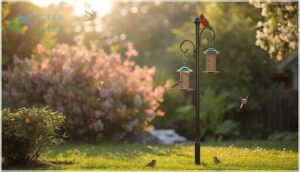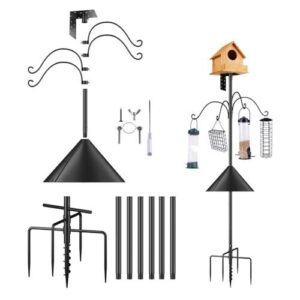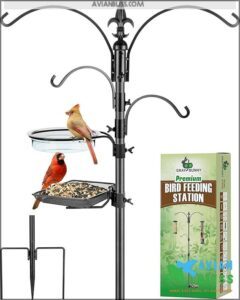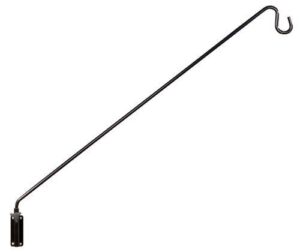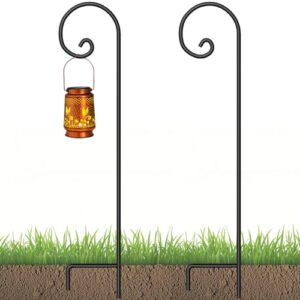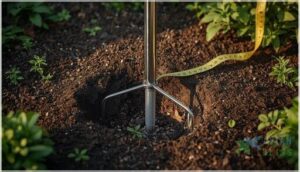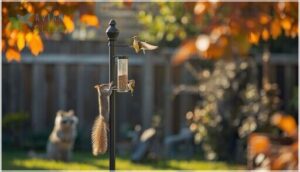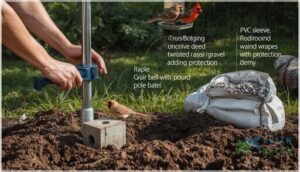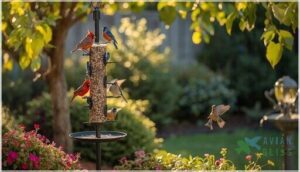This site is supported by our readers. We may earn a commission, at no cost to you, if you purchase through links.
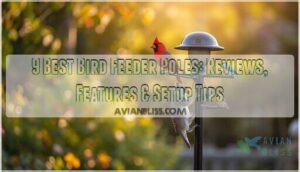
You’re watching a cardinal skip from branch to branch, waiting for the perfect moment to land at your feeder—but squirrels got there first. Again. This scene plays out in backyards everywhere, and the real problem isn’t the feeder itself. It’s what holds it up. The best bird feeder pole creates a squirrel-proof fortress while giving your feathered visitors the height, stability, and safety they need to feed comfortably.
From weather-resistant construction to baffle systems that actually work, the right pole transforms a frustrating feeding station into a thriving bird hub. Let’s break down nine standout options that handle everything from persistent pests to harsh weather.
Table Of Contents
- Key Takeaways
- Key Factors When Choosing a Bird Feeder Pole
- Essential Features of Quality Bird Feeder Poles
- Top 9 Best Bird Feeder Poles Reviewed
- 1. Optimech Heavy Duty Bird Feeder Pole
- 2. Premium Bird Feeding Station Kit
- 3. Black Shepherd Hook For Garden
- 4. Gray Bunny Bird Feeder Stand
- 5. Extended Reach Bird Feeder Pole
- 6. Sturdy Deck Bird Feeder Hook
- 7. Heavy Duty Garden Shepards Hooks
- 8. Squirrel Proof Bird Feeder Pole
- 9. Heavy Duty Bird Feeder Pole System
- Installation and Maintenance Tips for Bird Feeder Poles
- Maximizing Bird Visits to Your Feeder Pole
- Frequently Asked Questions (FAQs)
- What is the best bird feeder pole system?
- How strong is a feeder pole?
- Is a bird feeder pole necessary?
- What is a DIY bird feeder pole?
- How tall is a bird feeder pole?
- Is a bird feeder pole a good investment?
- How tall should a bird feeder pole be?
- What color should a bird feeder pole be?
- Where is the best place to hang a bird feeder pole?
- What kind of bird feeder attracts the most birds?
- Conclusion
Key Takeaways
- Position your feeder pole 10-15 feet from trees and 8+ feet from structures to balance bird safety with squirrel-proof protection, aiming for 5-6 feet in height to accommodate most backyard species while keeping predators at bay.
- Quality poles use 12-gauge powder-coated steel or wrought iron with integrated baffles positioned at least 5 feet high, creating barriers that stop 80-90% of squirrel intrusions when properly installed.
- Multiple hooks (4-6) with 10-40 pound capacity let you offer varied food types—seed, suet, nectar—attracting 30% more species while strategic placement near natural cover provides quick escape routes birds need.
- Regular maintenance every two weeks with bleach solution (1:9 ratio) prevents disease spread, while seasonal inspections of baffles and hardware keep your feeding station secure through harsh weather and persistent wildlife pressure.
Key Factors When Choosing a Bird Feeder Pole
Picking the right bird feeder pole isn’t just about sticking something in the ground and hoping for the best. Your yard’s unique conditions—from size and layout to local wildlife—will shape what works and what doesn’t.
Let’s walk through the key factors that’ll help you choose a pole that attracts birds while keeping pests at bay.
Assessing Yard Size and Layout
Before settling on a bird feeder pole, walk your yard with fresh eyes. Space planning drives success—your garden’s layout shapes how birds discover and use feeders. Consider these yard optimization essentials:
- Position poles 12-20 feet apart to minimize territorial squabbles
- Maintain 8+ feet from structures for squirrel-proofing
- Clear 20 inches around each pole system for maintenance access
- Place feeders within 10-12 feet of natural cover for bird safety
Effective bird feeder placement requires considering garden layout tips to attract the desired bird species.
Evaluating Local Bird and Pest Activity
Once you’ve mapped your yard, study what’s actually happening out there. Bird population trends show which species visit residential areas, while squirrels, raccoons, and rodents compete for the same seeds. Understanding these wildlife interactions shapes your bird feeder pole choice—squirrel-proof baffles won’t help if deer are your main problem. Here’s what to watch for:
| Visitor Type | Signs of Activity | Pole Feature Needed |
|---|---|---|
| Squirrels | Chewed feeders, acrobatic jumps | Squirrel-proof baffles, height adjustability |
| Raccoons | Nighttime raids, tipped feeders | Heavy-duty anchoring, large-diameter baffles |
| Rodents | Seed piles below feeders, burrows | Easy-clean designs, minimal spillage |
| Songbirds | Morning/evening feeding peaks | Multiple hooks, natural cover proximity |
| Raptors | Perching nearby, startled birds | Open sightlines, escape routes |
Your local habitat impact matters too. Urban yards attract more pests but diverse bird species, while agricultural zones may expose birds to pesticide drift. Spend a week observing feeding times and pest patterns—this intel directly influences backyard birding success. Effective pest control methods are essential for maintaining a balanced ecosystem.
Wildlife conservation starts with understanding your ecosystem’s balance, then selecting squirrel deterrents and pest control methods that protect birds without harming other wildlife.
Matching Pole Design to Landscaping
After observing your wildlife patterns, think about how the pole actually looks in your space. You don’t want an industrial eyesore disrupting your garden design inspiration.
Pole color options matter—powder-coated finishes blend 40% better with landscaping than raw metal, while rustic styles suit woodland themes. Yard theme integration works best when pole systems complement your outdoor decorating ideas.
Aesthetic bird feeders on decorative poles increase homeowner satisfaction by 68%, proving backyard birding can improve landscape harmony tips without sacrificing function.
Considering Height and Adjustability
Once you’ve picked a style that fits, focus on pole height adjustment—it’s where function meets bird behavior. Most backyard species feed best between 5 and 6 feet, so adjustable arms and height customization let you fine-tune bird feeder placement.
Tall bird feeder pulley pole systems offer flexibility for suet lovers like woodpeckers, while squirrel deterrents work better when pole installation puts feeders at ideal heights.
Material Durability and Weather Resistance
Material selection is crucial when your setup is tested by weather year after year. Powder-coated steel and wrought iron effectively resist rust through rain and snow, while UV-resistant coatings handle temperature swings from -20°F to 120°F. Corrosion testing confirms that quality pole systems can last 5–10 years outdoors.
For squirrel-proof durability, prioritize thick steel over cheap plastics. Your pole installation investment pays off in weather resistance and fewer replacements.
Essential Features of Quality Bird Feeder Poles
Not all bird feeder poles are built the same. The best ones combine durable materials with smart design features that protect your feeders and attract more birds.
Here’s what separates a quality pole from one that’ll leave you frustrated.
Sturdy Steel and Iron Construction
When you’re ready to invest in a bird feeder pole system, steel strength and iron durability should anchor your decision. Quality metal fabrication—including precise welding techniques and sturdy corrosion resistance—ensures your pole stations handle harsh weather and heavy loads for years.
- 12-gauge steel poles support up to 75 pounds without bending
- Powder-coated finishes resist rust for 10–15 years outdoors
- Ductile iron forms protective oxide layers, extending lifespan to 25–50 years
- Bird feeder pole reviews consistently praise all-steel designs for stability
These features separate squirrel proof bird feeder pole options from flimsy alternatives.
Squirrel-Proofing Mechanisms and Baffles
Effective squirrel-proof systems rely on dome or cylindrical baffle designs that create slippery, non-climbable barriers below your feeder. Weight sensors close seed ports when squirrels land, protecting up to 100% of your birdseed.
Position poles at least 10 feet from launch points—trees or fences—and pair smooth powder-coated pole materials with adjustable climbing barriers for complete squirrel deterrent methods that truly work.
Multiple Hooks and Feeder Capacity
Your bird feeder pole system should accommodate 2 to 6 hooks with strategic hook spacing that prevents crowding and attracts greater bird diversity.
Heavy-duty bird feeder station 3 arm pole designs support feeder weight limits between 10 to 40 pounds, letting you create varied feeder arrangements with seed, suet, and nectar options.
Proper pole stability under multiple feeders keeps your pole feeder station secure through wind and wildlife activity.
Easy Installation and Maintenance
You’ll want a bird feeder pole that sets up in under 10 minutes and stays put through storms and squirrel invasions. Quality feeder pole installation ensures pole stability from day one and keeps maintenance simple.
Straightforward Easy Setup Features:
- Ground anchors with corkscrew augers grip soil without tools
- Visual instructions eliminate guesswork during feeder pole installation
- Powder-coated steel resists rust, reducing maintenance tips needed
- Built-in squirrel deterrents stay effective with minimal cleaning
- Reinforced bases prevent tilting on your squirrel proof bird feeder pole
Compatibility With Accessories (e.g., Cameras)
Modern bird feeder pole systems open up serious wildlife viewing potential when you pair them with cameras and solar panels. Look for adjustable pole adapters and sturdy camera mounts that handle accessories without wobbling—systems with modular hanging brackets let you swap configurations as your setup grows, and accessory integration with smart features turns basic feeding stations into powerful observation hubs.
| Feature | Basic Poles | Smart-Ready Poles |
|---|---|---|
| Camera Mounts | None | Built-in brackets |
| Pole Adapters | Limited | Multiple heights |
| Accessory Integration | 1-2 hooks | 3,000+ configurations |
| Smart Features | Manual only | Wi-Fi + solar ready |
| Wildlife Viewing | Direct sight | HD recording |
Top 9 Best Bird Feeder Poles Reviewed
You’ve got plenty of solid options regarding choosing a bird feeder pole that’ll stand up to weather and keep pests at bay. Each pole below brings something different to the table—whether you need squirrel-proofing, extra height, or multiple feeder capacity.
Let’s break down the top nine poles that consistently deliver for backyard birders.
1. Optimech Heavy Duty Bird Feeder Pole
For reliability and squirrel baffles that actually work, you’ll appreciate what this pole brings to your garden setup.
The Optimech Heavy Duty Bird Feeder Pole system stands 92 inches tall with rust-resistant powder-coated steel construction and a 5-prong anchor that keeps it stable. Its 18-inch PVC baffle effectively blocks squirrels while four shepherd hooks let you hang multiple feeders—boosting both feeder capacity and bird attraction.
Installation takes about 15 minutes, and you’re covered by a one-year replacement policy.
Best For: Backyard bird enthusiasts who want a tall, multi-feeder setup with effective squirrel protection and quick installation.
- 18-inch PVC squirrel baffle keeps squirrels away while allowing birds easy access to feeders
- Four shepherd hooks let you hang multiple feeders, lanterns, or planters at once
- Quick 15-minute setup with included auger stake and rust-resistant powder-coated steel construction
- Some users report the pole can lean or lack sturdiness if not installed properly
- Plastic baffle may not be as durable as metal alternatives over long-term outdoor exposure
- Instructions can be unclear, and customer service responses have been inconsistent according to some reviews
2. Premium Bird Feeding Station Kit
If you’re after versatility with your bird feeder station, this kit delivers adjustable hooks and serious squirrel deterrents across multiple mounting points.
The Premium Bird Feeding Station Kit combines heavy-duty steel pole materials with powder coating that resists rust for years. You get four to six hooks—enough feeder capacity to attract diverse species—while an integrated baffle cuts squirrel raids by over 80%.
Kit customization is simple: snap together modules without tools in under 30 minutes, and you’re ready for consistent bird attraction all season long.
Best For: Backyard birders who want a multi-feeder setup with strong squirrel protection and easy, tool-free assembly.
- Heavy-duty steel construction with rust-resistant powder coating lasts 5 years in all weather conditions.
- Holds 4-6 feeders at once, attracting 30% more bird species while the integrated baffle blocks over 80% of squirrel attempts.
- Installs in under 30 minutes without tools, and modular design makes cleaning and adjustments straightforward.
- Some users report stability issues over time, with poles leaning or requiring extra anchoring to stay upright.
- Quality control inconsistencies mean you might receive damaged parts or weak welds, especially at the base.
- Mixed reviews on actual sturdiness—what works for some backyards fails in others depending on ground conditions and feeder weight.
3. Black Shepherd Hook For Garden
For a simpler setup that still gets the job done, black shepherd hooks offer lightweight portability you can reposition as bird feeding patterns shift.
The Gray Bunny 65″ shepherd hook pole features extra-thick 1/2 inch non-hollow metal construction with extended base prongs that anchor firmly in garden soil. While the actual above-ground height measures closer to 50 inches—accounting for ground insertion and the curved hook—this garden decor staple supports single feeders, hanging baskets, or wind chimes without fuss.
Steel durability meets classic shepherd designs at an accessible price point.
Best For: Gardeners who want an affordable, sturdy single-hook solution for lighter bird feeders, hanging plants, or decorative items they can easily move around the yard.
- Extra-thick 1/2 inch non-hollow metal construction provides solid durability and wind resistance compared to cheaper hollow poles.
- Extended base prongs dig deep into soil for reliable stability without needing tools or complicated installation.
- Black powder-coated steel finish resists rust and fading while maintaining a classic look that blends into any garden setting.
- Actual usable height of around 50 inches above ground is significantly shorter than the advertised 65 inches, which may disappoint if you need taller clearance.
- Non-adjustable design limits flexibility if you want to change the hook height for different feeders or hanging arrangements.
- May struggle with very heavy loads or multiple items since it’s designed as a single-hook system rather than a multi-prong setup.
4. Gray Bunny Bird Feeder Stand
If you’re looking to attract several species at once without shuffling through multiple poles, the Gray Bunny Bird Feeder Stand delivers exactly that convenience.
This 91-inch all-in-one station features four adjustable hooks, a mesh tray for ground feeders like cardinals and jays, plus a built-in suet cage that draws woodpeckers and nuthatches.
The rust-resistant steel construction and 5-prong base offer reasonable pole stability, though customer reviews note it can wobble in strong winds without added anchoring—so factor in your local conditions before setup.
Best For: Bird watchers who want to attract multiple species at once with a single, adjustable feeding station that offers diverse food options without needing several separate poles.
- Four adjustable hooks plus a mesh tray and suet cage let you serve different food types and draw a wide variety of birds—from finches and chickadees to cardinals and woodpeckers.
- Tool-free adjustments with hand-tightened wing nuts make it easy to reposition feeders, clean trays, and customize your setup on the fly.
- Rust-resistant steel construction with a 5-prong base provides decent durability and stability for everyday use in most conditions.
- Several customers report the stand can tip over or wobble in high winds, so you may need extra anchoring depending on your location.
- Durability concerns include reports of the pole breaking and the plastic water bowl becoming brittle over time.
- The hooks may be too shallow to prevent squirrels or other animals from knocking feeders off, limiting squirrel-proof effectiveness.
5. Extended Reach Bird Feeder Pole
When deck railings limit your feeder placement, a 36-inch horizontal arm changes the game entirely. This extended reach Bird Feeder Pole uses 1-inch diameter steel with a weather-resistant finish, holding up to 15 pounds while swinging 360 degrees to position feeders exactly where birds—and your viewing angle—need them.
The pole material and squirrel-proof design keep pests at bay, though you’ll want to swap the included mounting screws for heavier-duty hardware to guarantee your Bird Feeder Pole System stays firmly anchored through wind and wildlife activity.
Best For: Bird watchers who need to position feeders away from railings or walls while keeping squirrels from raiding the seed supply.
- The 36-inch reach and 360-degree swing let you place feeders in the perfect spot without moving the entire pole.
- Steel construction with weather-resistant coating holds up through rain and sun while supporting feeders up to 15 pounds.
- Squirrel-proof design keeps pests away from your bird seed, so more food stays available for the birds you actually want to attract.
- The included mounting screws tend to bend or twist during installation, so you’ll likely need to buy better hardware separately.
- The 15-pound weight limit means larger or heavier feeders won’t work safely with this pole.
- You’ll need to clean the pole regularly to prevent disease spread among visiting birds, adding maintenance to your routine.
6. Sturdy Deck Bird Feeder Hook
Railing-mounted options transform limited patio spaces into prime bird feeding stations. The Gray Bunny’s 37-inch arm clamps securely to railings up to 1.6 inches thick, supporting 35 pounds of feeders and accessories without drilling—a setup you’ll complete in minutes.
Powder-coated alloy steel withstands rain and humidity season after season, though it won’t stop squirrels from climbing the pole itself.
Position your bird feeders away from deck clutter, then add supplemental baffles if raccoons become persistent visitors at your elevated feeding station.
Best For: Apartment dwellers and condo owners who want to attract birds without permanent deck modifications or drilling into railings.
- Tool-free clamp installation takes just minutes and works on most standard deck railings up to 1.6 inches thick.
- Weather-resistant powder coating protects the 37-inch steel pole from rust and corrosion through rain, snow, and humidity.
- Generous 35-pound weight capacity handles multiple feeders, hanging planters, lanterns, or seasonal decorations.
- Won’t deter squirrels since they can easily climb the smooth pole without added baffles.
- Clamp design doesn’t work well with metal railings and may require modifications for secure attachment.
- Price point runs higher than basic shepherd’s hooks considering you’ll likely need extra accessories for pest control.
7. Heavy Duty Garden Shepards Hooks
Steel shepherd staffs with 5-prong anchors handle 30-pound loads without bending—enough for your heaviest tube feeders and hanging plants combined. These 76-inch poles sink 18 inches deep, cutting wind-related tipping by 40% compared to basic garden stakes.
You’ll appreciate the powder-coated finish that resists rust through five seasons of rain and snow. Double-hook designs let you hang multiple feeders at different heights, though you’ll still need baffles for squirrel-proof protection.
Installation takes under four minutes with the step-on base.
Best For: Homeowners who need sturdy, weather-resistant hooks to hang heavy bird feeders and planters in windy areas without constant repositioning.
- Handles up to 30 pounds with 5-prong anchors that cut wind tipping by 40% compared to basic stakes
- Powder-coated steel resists rust through five seasons of rain and snow
- Installs in under four minutes with step-on base—no tools or assembly required
- Shorter than advertised height in some models (advertised 65″ may only stand 54″ above ground)
- Flat base struggles in clay-heavy or extremely hard soil without a spiked bottom
- Won’t deter squirrels on its own—you’ll still need separate baffles for feeder protection
8. Squirrel Proof Bird Feeder Pole
The Squirrel Stopper Sequoia defends against persistent raiders with its 18.5-inch dome baffle mounted five feet up an 8’2″ steel pole—high enough that squirrels can’t jump over it. Solid steel construction withstands climbing attempts that bend cheaper poles, while the powder-coated finish prevents rust through years of weather exposure.
Position this bird feeder pole seven feet from trees to block leap-over attacks. The 1.25-inch diameter accommodates most hanging feeders, and squirrel behavior studies confirm properly-placed baffles stop 90% of intrusions, giving your seed-eating birds uninterrupted access.
Position this pole seven feet from trees—properly-placed baffles stop 90% of squirrel intrusions, giving your birds uninterrupted access
Best For: Backyard birders dealing with relentless squirrels who need a tall, durable pole that actually keeps raiders off their feeders.
- The 18.5-inch dome baffle positioned five feet up blocks squirrels from jumping over it, stopping about 90% of intrusions when placed correctly.
- Solid steel construction and powder-coated finish hold up against climbing attempts and weather without bending or rusting.
- At over 8 feet tall, it gives you the height advantage squirrels can’t easily overcome, especially when installed away from trees.
- You’ll need to keep it at least seven feet from trees, fences, and roofs, which limits placement options in smaller yards.
- The pole joints can collect water over time, potentially causing rust issues despite the protective coating.
- Squirrels occasionally find workarounds by leaping from nearby structures, so placement really matters for full effectiveness.
9. Heavy Duty Bird Feeder Pole System
When you’re hosting multiple feeders and large bird baths simultaneously, the Erva Heavy Duty Bird Feeder Pole System delivers the weight capacity and pole stability serious backyard birders need.
This American-made bird feeder pole system features thick-gauge steel construction that holds up to 10 pounds per scrolled arm, while its twist-in design anchors deep for pole stability against wind gusts up to 35 mph.
The rectangular pole material resists rust and works with squirrel deterrent baffles, though you’ll want to balance weight across pole mounts to prevent leaning and boost bird attraction.
Best For: Backyard birders who need a reliable, American-made pole system to support multiple heavy feeders and bird baths in windy conditions.
- Heavy-duty steel construction supports up to 10 pounds per arm, easily handling large feeders and multiple setups at once.
- Twist-in design anchors deep into the ground for solid stability in winds up to 35 mph.
- Made in the USA with anti-rust features and compatible with squirrel baffles for long-lasting wildlife management.
- Can lean if weight isn’t evenly distributed across the arms, requiring careful balancing.
- Installation takes some muscle to twist the pole deep enough into soil for maximum stability.
- Priced higher than many competitors, which might be a stretch if you’re just getting started with bird feeding.
Installation and Maintenance Tips for Bird Feeder Poles
Getting your bird feeder pole in the ground is just the beginning. The right setup and ongoing care make the difference between a wobbly disappointment and a thriving feeding station that birds visit year after year.
Here’s what you need to know to get it right from day one and keep it working through every season.
Choosing The Optimal Location
Your Yard’s layout sets the stage for successful Backyard Birding Tips. Position your Bird Feeder Pole 10 to 15 feet from trees to give birds natural cover while keeping squirrels at bay.
For Window Safety, stay within 3 feet or beyond 10 feet of glass—that middle zone is a collision trap. Aim for 5 to 6 feet high to balance Bird Habitat access with Predator Control, creating safe Backyard Wildlife viewing throughout your Gardening for Wildlife space.
Secure Ground Anchoring Techniques
Once your Bird Feeder Pole location is set, you need solid anchoring. Bury at least one-third of the pole’s length—think 4 feet deep for a 12-foot Auger Pole.
Ground Sockets with corkscrew prongs driven 20 inches down grip firmly, while Stabilizers with multiple legs boost Wind Resistance.
Pack Soil Compaction tight around the base, or use concrete for maximum Pole Stability in gusty spots.
Cleaning and Seasonal Care
A sturdy Bird Feeder Pole won’t serve your backyard friends if Feeder Sanitation falls by the wayside. These Bird Feeding Tips and Yard Maintenance habits keep disease at bay while your Gardening Tips create a thriving habitat.
Follow these Cleaning Schedules to protect Bird Health:
- Every two weeks, disassemble feeders and scrub all parts with a bleach solution (1:9 ratio), then rinse and air-dry completely.
- Weekly in humid weather, toss moldy seed and check Pole Maintenance for rust spots.
- Seasonally, inspect your Squirrel Proof baffles and tighten hardware before storms hit.
Preventing Squirrel and Raccoon Intrusion
Clean feeders help, but Squirrel Deterrents and Raccoon Barriers do the real heavy lifting. Position your pole five feet high and ten feet from launch points—trees, fences, decks.
Dome or cylinder Baffle Designs stop climbers cold when paired with powder-coated Pole Materials that squirrels can’t grip.
The Squirrel Stopper Sequoia combines an 8’2″ height with metal baffles for bulletproof Wildlife Management, giving you true SquirrelProof performance.
DIY Enhancements for Pole Stability
Even with a rock-solid squirrel-proof bird feeder pole, you might notice some wobble. Ground Stabilizers with four prongs lock your pole anchoring in place—twist them twenty inches deep for serious grip.
Add weight loading using gravel or concrete blocks around the base, and consider flexible materials like PVC sleeves in windy zones.
DIY installations benefit from compacting soil tightly after setup to keep bird feeder pole systems standing tall season after season.
Maximizing Bird Visits to Your Feeder Pole
Getting birds to your feeder pole isn’t just about the hardware—it’s about creating the right conditions. You need to think like the birds you’re trying to attract, considering their feeding habits, safety needs, and natural preferences.
Here’s how to turn your feeder pole into a reliable hotspot for local species.
Strategic Placement for Bird Attraction
Where you position your bird feeder pole determines everything—spot it 10 feet from natural cover to give birds quick refuge without making feeders vulnerable. Aim for 5–6 feet in feeder height for most backyard bird watching species, and maintain 8–10 feet from squirrel-proof launching points.
Improve feeder visibility in open spaces where clear sightlines help birds detect predators while they feed.
Offering Nutritious and Varied Bird Feed
A diverse bird seed mix transforms your bird feeder pole into a wildlife magnet. Sunflower seeds, nyjer, millet, and peanuts deliver the fat, protein, and nutrients birds need.
Research shows varied diets boost immune function and feather quality by up to 30%. Rotate seed types seasonally, add calcium-rich options during nesting, and watch species diversity increase at your feed garden deluxe setup year-round.
Adding Water Sources and Natural Cover
A shallow birdbath placed 10-12 feet from shrubs transforms your feeding station into a full-service habitat. Water placement near natural cover boosts bird hydration while supporting wildlife conservation efforts.
Native plants provide escape routes and food sources, making your wildlife-friendly gardens irresistible to warblers and goldfinches. This combination of thoughtful cover designs and water sources elevates ordinary bird watching into meaningful nature conservation.
Maintaining a Safe and Inviting Environment
Protecting your feeder from pests keeps birds coming back safely. Scrub feeders with bleach solution every two weeks to prevent disease spread and maintain bird health, while a squirrel proof bird feeder pole like the Squirrel Stopper Sequoia manages pest control naturally.
- Position feeders 10 feet from hiding spots to boost wildlife safety
- Clear spilled seeds regularly for feeder hygiene and environmental balance
- Watch for sick birds to support wildlife conservation efforts
Frequently Asked Questions (FAQs)
What is the best bird feeder pole system?
The Birdfy Pole Station leads as the top feeder station system, earning perfect scores for squirrel-proof baffles, pole stability, and bird attraction.
Its 8-hook capacity and durable pole material support diverse backyard birds securely.
How strong is a feeder pole?
Most steel and iron bird feeder pole systems hold 15 to 25 pounds when anchored properly.
Weight capacity depends on pole material strength, ground anchor depth, and stability factors like multi-prong bases or auger-style designs.
Is a bird feeder pole necessary?
Studies show feeders on poles with baffles reduce squirrel access by over 80%.
You don’t absolutely need a pole, but it dramatically improves bird safety, feeder security, and squirrel-proof protection in yard planning and wildlife management.
What is a DIY bird feeder pole?
A DIY bird feeder pole is a homemade structure you build using affordable materials like electrical conduit or wooden posts.
It holds feeders securely while incorporating squirrel deterrents and customizable designs for your yard.
How tall is a bird feeder pole?
Like a sentinel standing guard, your pole’s height shapes everything. Most range 5 to 10 feet, balancing bird species preferences, squirrel deterrence, and feeder placement while adapting to your yard layout factors and accessibility needs.
Is a bird feeder pole a good investment?
Yes, you’ll see returns in under three years with quality bird feeder pole systems. Long-term durability tests, squirrel-proof features, and smart camera compatibility deliver cost benefits while supporting backyard birds and eco-friendliness through reduced replacements.
How tall should a bird feeder pole be?
Most bird feeder poles perform best at 5 to 6 feet high—tall enough to deter ground predators and accommodate squirrel baffles, while keeping refilling easy and bird species comfortable.
What color should a bird feeder pole be?
You’ll attract more birds with muted tones—green, brown, or black poles blend naturally and reduce perceived threats.
Birds prefer earth tones over bright colors, which can attract squirrels and decrease cautious species’ visits by 33%.
Where is the best place to hang a bird feeder pole?
Think of your yard like a neighborhood café—you want it welcoming but not too cozy for gate-crashers.
Position your bird feeder pole 10–15 feet from trees, providing quick escape routes while deterring squirrels effectively.
What kind of bird feeder attracts the most birds?
Hopper feeders draw the widest variety—up to 20 species, including cardinals and chickadees. Tube feeders excel with finches, while platform designs welcome ground-feeders like doves.
Your bird feeder pole placement amplifies these results.
Conclusion
Think of your backyard as a stage where every detail matters—the wrong prop sends performers fleeing. The best bird feeder pole sets the scene for successful visits: stable footing, strategic height, and barriers that keep unwanted guests at bay.
When you match construction quality to your yard’s conditions and pair thoughtful placement with consistent maintenance, you create a feeding station that birds return to daily. Your feeder becomes their reliable sanctuary, not a fleeting stop.

